|
 OUDF
- Oceanic
Union Defence Force OUDF
- Oceanic
Union Defence Force
The Oceanic Union Defence Force Navy and
Oceanic Union Patrol Fleet
The Spacefaring military arm of the Oceanic Union is divided into two separate
organizations, the OUDF Navy (OUDFN) and the much larger OU Patrol Fleet (OUPF). The former is a purely military
organization, whose ship names are prefixed by OUDFS (usually pronounced 'Odd Fuss'), the latter a paramilitary
organization whose ships names are prefixed by OUPS (pronounced "Oops"). In times of crisis, many OUPF ships serve alongside their purely-military cousins, and there seems to be little difference in practice. Due to practical experience in anti-piracy duties and exploration in disputed territory, the OUPF ships often have better gunnery skills, despite having somewhat less military training. OUDFN ships are often painted in individualistic colour schemes, often aboriginal,
maori, abstract or
Polynesian motifs using earth colours. OUPS ships are a basic medium blue, sometimes with an abstract design, often not.
This page is an update of the original OUDF pages still available <here>.
The format has changed and the SSDs have been updated to be in more of a
Fleet Book format. Point values have been tweeked a bit to make them
more consistant Pictures of painted OUDF miniatures from GZG
are courtesy of 'goblinpaladin' and you can seem more of them on his
blog
 History and Organization History and Organization
The History of the OUDF's activities in space is shrouded in some mystery. Various sources contradict each other, and it is official policy of the OUDF to say little to clear up the confusion. Some sources put the beginnings of the OUDFN as far back as the original Gilderstein Foundation experiments, others state that the OUDF was the last of the minor powers to enter space, behind the Indonesian Commonwealth and
LLAR.
What is certain is that by the 2180s, the Oceanic Union has claimed vast numbers of mainly M-class star systems, and has placed navigation and communications buoys on them. These systems are for the most part completely valueless, no other power has bothered to claim them. Should the OU find anything of value, it has often found the system taken from it by force
majeure. However, the OU has reasonably good diplomatic relations with all the major powers, and is adept at playing them off against each other. It is also expert at
asymmetrical warfare - OU raiders are Vandals par excellence, able to strike in unexpected places, cause vast monetary damage, and withdraw with few casualties on either side. Many nations and even some of the larger
organizations have taken OU territory and kept it: but none have profited thereby, and usually they are all too glad to give it back. The OU provides a valuable service to all spacefaring nations, providing navigational beacons, keeping down piracy, providing search-and-rescue services, and its large patrol fleet's regular visits both in and out of OU space are often the only lifeline some of the smaller scientific and industrial colonies have to the rest of humanity.
Ship Design Doctrine
The bulk of OUDF ships in the 2180s have been built relatively recently, in the very ambitious Basic Operational Refit Of Navy (BORON)
programme. This unique design philosophy
emphasizes ease of construction of a few basic designs, each capable of being fitted with
interchangeable modules. A nearly unarmed patrol ship may thus be converted to a fully capable heavy destroyer, a light cargo vessel, a commando raider, or even a fleet escort in a matter of weeks. This has meant that the very large OUPF is composed mainly of one basic design, cheap to operate and very reliable. In times of crisis, many of these vessels would be given military modules, and take their place as escorts in the battle line. Many of the OUDF Navy's ships are non-BORON designs though, often based on NAC designs, and are
optimized for either long-range firepower with powerful beams and missiles, or really close action using massed scatterpack launchers.
BORON ships are noted for their toughness, but are considered somewhat under-armed compared with the ships of most other navies. Due to the limitations of modular weaponry, they are unable to use the heavier beams and still retain their advantages of cheapness and reliability. This does however fit in well with OUDF doctrine, which
emphasizes a long-range strike, followed by rapidly closing to 'decisive range' where the smaller beams firepower is greatly increased.
OUDF Modules
The core
of the BORON program is the module. Each module containts 8 mass of
weapons or systems and they can be mounted on ships as needed depending on
the situation and role.
|
Standard Module
 Quite commonly fitted to escort carriers, but also sometimes on others when operating against missile-using enemy. Quite commonly fitted to escort carriers, but also sometimes on others when operating against missile-using enemy.
Cost: 24 NPV/CPV
Crew: 2 Officers, 6 Ratings: 2 Officers, 6 Ratings
2 Class 2 Batteries, 2 Class 1 Batteries, 2 Point Defence Systemss
|
Gunpack Module
 The most usual module for Cruisers. The most usual module for Cruisers.
Cost: 24 NPV/CPV
Crew: 3 Officers, 5 Ratings
3 Class 2 Batteries, 1 Class 1 Battery, 1 Point Defence System
|
Missile Module
 Used mainly by escort ships to support carriers with additional missile fire. Used mainly by escort ships to support carriers with additional missile fire.
Cost: 24 NPV/CPV
Crew : 2 Officers, 6 Ratings
1 Class 2 Battery, 1 Extended Range Salvo Missile Rack, 1 Point Defence System.
Other versions exist replacing the ER-SMR with either 2 MT racks or a single MR-SMR, plus a Class 1 Battery.
|
|
Defence Module
 At least one, and often several, ships in a fleet will be equipped with this module. This is also a popular module to put on Escort Carriers. At least one, and often several, ships in a fleet will be equipped with this module. This is also a popular module to put on Escort Carriers.
Cost: 26 NPV/CPV
Crew: 4 Officers, 4 Ratings
2 Class 1 Batteries, 4 Point Defence Systems, 1 Area Defence Fire Control System.
|
Torpedo Module
 Produced as an interim measure until Spider class vessels were available.. Produced as an interim measure until Spider class vessels were available..
Cost: 25 NPV/CPV
Crew: 3 Officers, 5 Ratings
1 Class 2 Battery, 1 Pulse Torpedo Tube, 1 Fire Control
System, 1 Point Defence System |
Raider Module
 Standard light attack transport. Standard light attack transport.
Cost: 12 NPV 6 CPV
Crew: 2 Officers, 6 Ratings
1 Point Defence System, 1 Hanger containing space for 10-tonne, or 1 20-tonne landing craft, 40 tonnes troop
accommodation.
|
|
Survey Module
 Hanger
space for a variety of probes, landers and buoys. Accommodation space for
lab instruments, sensors, and exploration teams. Can be easily
re-configured into a Raider Module. Hanger
space for a variety of probes, landers and buoys. Accommodation space for
lab instruments, sensors, and exploration teams. Can be easily
re-configured into a Raider Module.
Cost: 12 NPV 6 CPV
Crew: 5 Officers, 3 Ratings
1 Point Defence System,
|
Diplomatic
Transport
(VIP)
Module
 Extensive
and luxurious accommodations for VIPs, a very popular export model. Extensive
and luxurious accommodations for VIPs, a very popular export model.
Cost: 12 NPV/CPV
CrewCrew: 6 Officers, 2 Ratings
1 Point Defence System, 1 Class 2 Battery.
|
Secure Transport Module
 It is suspected that several VIP modules sold for export have been converted to this configuration for use by Pirates and Smugglers. In OU service, it is used for high-value cargo, or for transport in insecure areas. It is suspected that several VIP modules sold for export have been converted to this configuration for use by Pirates and Smugglers. In OU service, it is used for high-value cargo, or for transport in insecure areas.
Cost: 12 NPV/CPV
Crew: 2 Officers, 6 Ratings
1 Point Defence System, 1 Class 2 Battery. 40 Tonnes cargo space.
|
|
Cargo Module
 Cost: 0
NPV/CPV Cost: 0
NPV/CPV
Crew: 1 Officer, 7 Ratings
80 Tonnes cargo space
|
Research Module
 Cost: 0
NPV/CPV Cost: 0
NPV/CPV
Crew: 8 Officers
Fitted with a variety of sensors and scientific analysis equipment.
|
|
|
|
|
|
|
Snake class HEAVY FRIGATE
FT-904
TMF: 24
NPV: 79 / CPV: 61
Technical Specifications
Classification : Frigate
Displacement : 2400 Tonnes [MASS Factor 24]
Hull Type : Average [Hull Integrity 7]
Crew : 5 Officers, 19 Ratings
Armament : 1 Class 2, 2 Class 1 Batteries
Defences : 1 Point Defence System, Grade 1 Armour
Sensor Suite : Standard sensors, 1 Fire Control System
Drive Systems : Main Drive rating 7, FTL (Jump) Drive
Service Details
First entered service : 2175
Currently in OU service : 22
Lost in action : 7
Decommissioned/scrapped : 9
Relegated to reserve fleet : 2
Sold to other forces : 2
Under construction : 13
Procurement cost : 790 MUcr
|
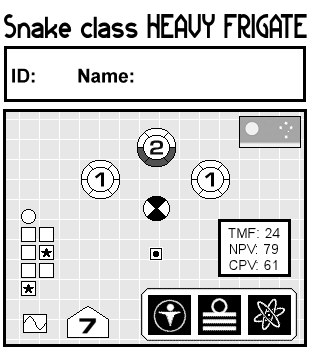
|

|
The Snake class was designed to meet an OUDF specification for a very fast, heavily armed Frigate, capable of out-running anything it couldn't out-fight, and out-fighting anything it couldn't out-run. Lee-Lu shipyards
proposed solution was based on grafting the drives of their standard
River/Freemantle class Patrol Vessel onto a purpose-built hull only half the size. Although highly successful due to its use of standard components, it is the least popular of all the BORON designs, due to cramped (by OU standards)
accommodation.
|
|
Spider class TORPEDO BOAT
FT-904
TMF: 24
NPV: 79 / CPV: 61
Technical Specifications
Classification : Frigate
Displacement : 2400 Tonnes [MASS Factor 24]
Hull Type : Average [Hull Integrity 7]
Crew : 4 Officers, 20 Ratings
Armament : 1 Pulse Torpedo Tube
Defences : 1 Point Defence System, Grade 1 Armour
Sensor Suite : Standard sensors,1 Fire Control System
Drive Systems : Main Drive rating 7, FTL (Jump) Drive
Service Details
First entered service : 2179
Currently in OU service : 12
Lost in action : 3
Decommissioned/scrapped : 1
Relegated to reserve fleet : 2
Sold to other forces : 0
Under construction : 14
Procurement cost : 790 MUcr
|

|
 |
The Spider class , although externally indistinguishable from its predecessor, the Snake class, is actually a new design. Lessons learnt from the Snake class were incorporated into it, and the armament was completely revised. The Spider class is designed specifically to attack the most heavily screened enemies, and operates in packs. Popularly known as the "Banzai Boats".
|
|
|
|
|
|
Freemantle class
PATROL VESSEL |
|
|
FT-905
TMF: 32
NPV: 99 / CPV: 77
Technical Specifications
Classification :
Destroyer
Displacement : 3200 Tonnes [MASS Factor 32]
Hull Type : Very Strong [Hull Integrity 16]
Crew : 5 Officers, 27 Ratings
Armament : 1 Class 1 Battery
Defences : Grade 2 Armour
Sensor Suite : Standard sensors, 1 Fire Control System
Drive Systems : Main Drive rating 5, FTL (Jump) Drive
Service Details
First entered service : 2163
Currently in OU service : 0
Lost in action : 27
Decommissioned/scrapped : 21
Relegated to reserve fleet : 142
Sold to other forces : 33
Under construction : 24
Procurement cost : 990 MUcr
|

|

|
|
The Freemantle Class was the first of the BORON designs,
and has been the subject of numerous minor changes to improve its
performance since the first one was laid down in 2162.
Unlike all other modular designs, only the original
Freemantle class is capable of operating without a payload module being
fitted. The Jump drive has significant excess capacity, and is operated in
a de-tuned mode to conserve reliability and increase range. Freemantle
class patrol vessels are capable of taking on all but the most heavily
armed pirates or smugglers, but are primarily patrol, police and customs
vessels, with no significant military capability.
This has proved a very popular design in both para-military
and tio a lesser extent, commercial service, with significant numbers
being produced for export.
|
|
River class DESTROYER
FT-905
TMF: 40
NPV: 107 + module
CPV: 83 + module
Technical Specifications
Classification : Destroyer
Displacement : 4000 Tonnes [MASS Factor 40]
including payload module
Hull Type : Strong [Hull Integrity 16]
Crew : 5 Officers, 27 Ratings + Module Crew
Armament : 1 Class 1 Battery ( + module)
Defences : Grade 2 Armour (+ module )
Sensor Suite : Standard sensors, 1 Fire Control
System (+ module)
Drive Systems : Main Drive rating 4, FTL (Jump)
Drive
Service Details
First entered service : 2163
Currently in OU service : 45
Lost in action : 0
Decommissioned/scrapped : 0
Relegated to reserve fleet : 33
Sold to other forces : 0
Under construction : 0
Procurement cost : 990 MUcr + Payload Module 80-340 MUcr
|

|

|
|
The Freemantle Class when fitted with a payload module is
known as the River class. The base design's FTL over-capacity is easily
able to cope with the additional 25% mass, though the manouvre drive is of
necessity constrained to operate at slower speeds. Hull integrity suffers
somewhat too, the additional mass contributing nothing to the overall
ship's strength.
Most River class ships of the OUPF are fitted with either
cargo, survey, or research payload modules, though sometimes a Gunpack is
fitted as a nasty surprise for Pirates.
The River class are indeed "maids of all work"
for the OUDFN, acting in the roles of light cruiser, escort cruiser,
destroyer and attack transport with equal facility.
|
|
|
|
|
|
OUPS Guadalcanal
Fitted out for battle as a Gunpack destroyer
 |
OUPS Fly
In her most common role as armed light transport
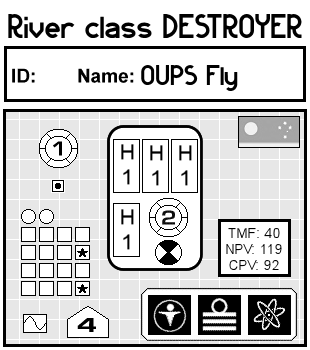 |
OUPS Sepik
Fitted out as a recon/raider for special missions
 |
OUDFS Yarra
In the common Fleet Escort configuration
 |
|
|
|
|
|
|
Numbat class LIGHT CRUISER
FT-906
TMF: 63
NPV: 184 + module
CPV: 161 + module
Technical Specifications
Classification : Light Cruiser
Displacement : 6200 Tonnes [MASS Factor 62] including payload module
Hull Type : Average [Hull Integrity 19]
Crew : 8 Officers, 46 Ratings + Module Crew
Armament : 1 Class 2 Battery, 1 Class 1 Battery ( + module)
Defences : Grade 2 Armour, 1 Point Defence System, Level 1 Screens (+ module )
Sensor Suite : Standard sensors,2 Fire Control Systems (+ module)
Drive Systems : Main Drive rating 4, FTL (Jump) Drive
Service Details
First entered service : 2170
Currently in OU service : 17
Lost in action : 4
Decommissioned/scrapped : 4
Relegated to reserve fleet : 2
Sold to other forces : 8
Under construction : 2
Procurement cost : 1730 MUcr + Payload Module 80-340 MUcr
|
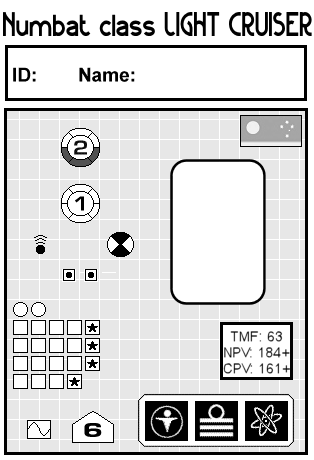
|

|
|
The Numbat class is a further development of the River/Freemantles. A new, more powerful manouevre drive was fitted to a slightly expanded River hull. The Numbats never did reach their design acceleration, and this failure led to the development of the Snake/Spiders, where the Freemantle's proven original drive was used on a cut-down hull with rather more success.
Despite this failure, the Numbats have been quite successful in the role of light cruisers, and are popular ships amongst their crews.
2 Numbats in OU service and most manufactured for export have been fitted on a semi-permanent basis as diplomatic transports, with VIP payload modules.
|
|
OUDFS Numbat
As Torpedo Cruiser, before the Spider class was constructed.
 |
OUDFS Nandi
One of two VIP transports in OU service.
 |
OUDFS Kombilol
Ready for heavy combat with a Gunpack module
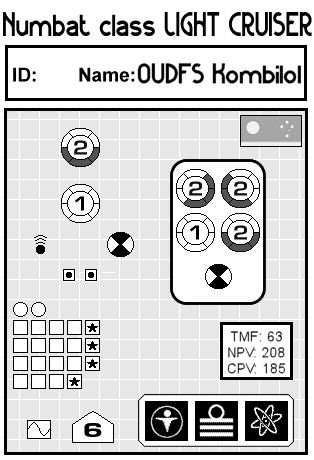 |
OUDFS Walpurti
Deployed with a missile module when escorting carriers
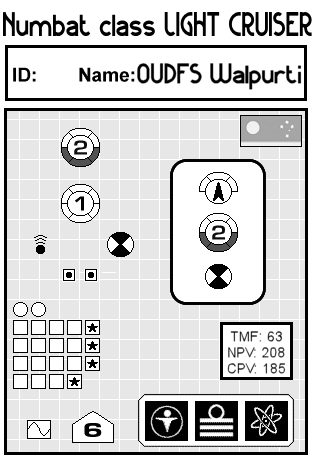 |
|
|
|
|
|
Tuvalu Block I class HEAVY CRUISER |
|
|
FT-908
TMF: 81
NPV: 227 + modules
CPV: 212 + modules
Technical Specifications
Classification : Heavy Cruiser
Displacement : 8100 Tonnes [MASS Factor 81] including 2 payload modules
Hull Type : Average [Hull Integrity 24]
Crew : 9 Officers, 56 Ratings + Module Crew
Armament : 2 Class 2 Batteries, 1 Class 1 Battery ( + modules)
Defences : Grade 3 Armour, 2 Point Defence Systems, Level 1 Screens (+ modules )
Sensor Suite : Standard sensors,2 Fire Control Systems (+ modules)
Drive Systems : Main Drive rating 4, FTL (Jump) Drive
Service Details
First entered service : 2172
Currently in OU service : 10
Lost in action : 4
Decommissioned/scrapped : 1
Relegated to reserve fleet : 6
Sold to other forces : 0
Under construction : 3
Procurement cost : 2110 MUcr + Payload 160-680 MUcr |
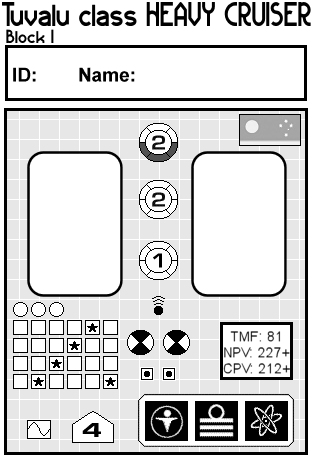
|
 |
|
The Tuvalu class was the first of the BORON designs not to be directly derived from the Freemantle class. It was conceived as a "double Freemantle", each vessel having at least twice the capability of the smaller ships. The design was not deemed a great success, as the problems involved in having two modules on one ship caused the programme cost to blow out alarmingly, and their expense is very high - comparable to more conventional designs.
Production was soon switched to the Block II design, which traded in the ability to carry two modules for a greatly increased structural strength. Recently, however, the Block I Tuvalu has been reinstated in production, the resultant ships usually carrying two different types of pod, one military, one not, so they become self-escorting troop transports, self-escorting cargo carriers and so on.
|
|
Tuvalu Block II class HEAVY CRUISER |
|
|
FT-908
TMF: 81
NPV: 246 + modules
CPV: 228 + modules
Technical Specifications
Classification : Heavy Cruiser
Displacement : 8100 Tonnes [MASS Factor 81] including payload module
Hull Type : Very Strong [Hull Integrity 32]
Crew : 10 Officers, 63 Ratings + Module Crew
Armament : 2 Class 2 Batteries, 1 Class 1 Battery ( + module)
Defences : Grade 3 Armour, 2 Point Defence Systems, Level 1 Screens (+ module )
Sensor Suite : Standard sensors,2 Fire Control Systems (+ module)
Drive Systems : Main Drive rating 4, FTL (Jump) Drive
Service Details
First entered service : 2174
Currently in OU service : 19
Lost in action : 1
Decommissioned/scrapped : 3
Relegated to reserve fleet : 1
Sold to other forces : 0
Under construction : 3
Procurement cost : 2350 MUcr + Payload 80-340 MUcr |
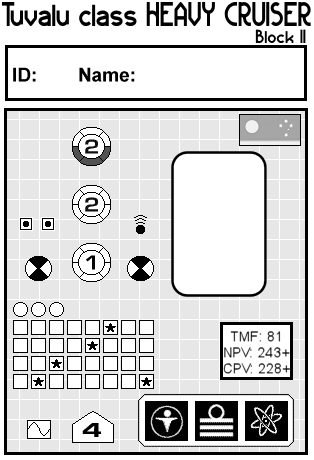
|

|
|
The Tuvalu Block II class is the mainstay of the OUDF Navy's Cruiser squadrons. Originally procured as a cheaper, less-capable variant of the Tuvalu after the fiasco of that class's cost blowout, it was soon found to be equally as effective, and significantly cheaper. Although rather under-armed for a vessel of its size, it has the ability to take punishment equal or superior to many battlecruisers and still remain effective.
Tuvalu Block IIs are nearly always fitted with Gunpack modules.
|
|
OUDFS Tiki
(Tuvalu Block I)
As she appeared at the battle of Esperance
 |
OUDFS Taronga
(Tuvalu Block I)
Fitted out as a research/survey cruiser
 |
OUDFS Tonga
(Tuvalu Block I)
Set up in Transport Cruiser Configuration
 |
OUDFS Tahiti
(Tuvalu Block II)
In the usual Gunpack Configuration for Blk II ships
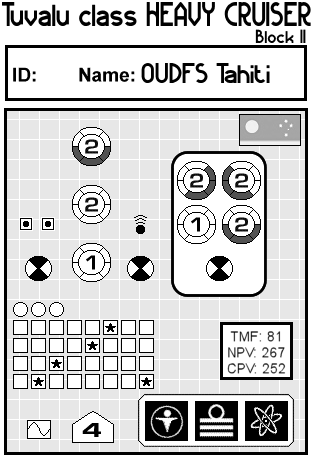
|
|
|
|
|
|
Waikato class ESCORT CARRIER |
|
|
TMF: 102
NPV: 322 + module & fighters
CPV: 255 + module & fighters
Technical Specifications
Classification : Escort Carrier
Displacement : 10200 Tonnes [MASS Factor 102] including payload module
Hull Type : Average [Hull Integrity 31]
Crew : 14 Officers, 80 Ratings + Module Crew
Armament : 1 Class 2 Battery, 1 Class 1 Battery ( + module)
Defences : Grade 3 Armour, 1 Point Defence System, Level 1 Screens (+ module )
Sensor Suite : Standard sensors,2 Fire Control Systems (+ module)
Drive Systems : Main Drive rating 4, FTL (Jump) Drive
Service Details
First entered service : 2171
Currently in OU service : 11
Lost in action : 4
Decommissioned/scrapped : 3
Relegated to reserve fleet : 1
Sold to other forces : 0
Under construction : 2
Procurement cost : 3140 MUcr + Payload 80-340 MUcr |
 |
 |
|
The Waikato class is the third basic design of the BORON family of ships. The lead ship of the class, Waikato, was originally designed without the capability of taking the interchangeable modules that all other large BORON ships could. However, she was upgraded to the same configuration as her sister ships in her first 5-year refit.
Weetangera and Wollondilly have both had their hangers replaced on a semi-permanent basis, and operate in the role of battleships. Weetangera has 2 Salvo Missile Launchers sharing a single magazine, and Wollondilly a cluster of 9 Heavy MT missiles racks, but both have the ability to be converted back to carrier configuration at a few months notice. Wagga and Worambungle have in the past had one hanger replaced by a Salvo Missile Launcher and magazine, but both are now currently of pure-carrier configuration.
Wanganui is often used for Special Ops, with a Raider module fitted semi-permanently. One hanger provides atmosphere-capable fighters for air support to the SAS or Light Horse raiders, the other additional hanger space for landers.
|
|
OUDFS Woranora
In standard configuration,
usually one squadron of
standard and one squadron of heavy fiighters (48 NPV, 108 CPV) 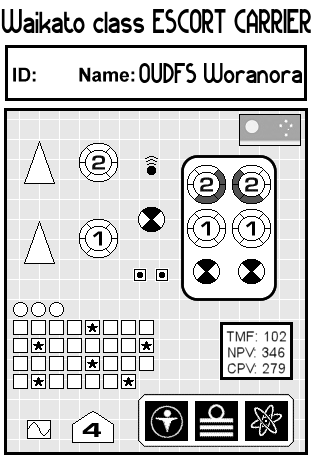 |
OUDFS Wanganui
This ship has a reputation for suddenly appearing out of nowhere, executing a surgical raid against valuable assets, and vanishing back into space.
Usually carries heavy fighters (NPV 60, CPV120)
 |
OUDFS Weetangera
Semi-permanent modification to 'battleship' role with 2
Salvo Missile Launchers sharing a single magazine
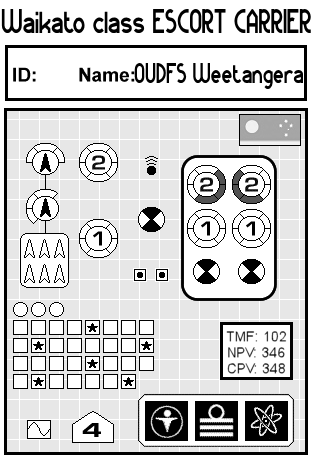 |
OUDFS Wollondilly
Semi-permanent modification to 'battleship' role replacing fighter
bays with a cluster of 9 Heavy MT missiles racks
 |
|
|
|
|
|
|
Dunedin class BATTLECRUISER |
|
|
Sister ships: Darwin, Downer, Deakin, Dickson....
FT-909
TMF: 111
NPV: 319 + modules
CPV: 331 + modules
Technical Specifications:
Classification : Battlecruiser
Displacement : 11100 Tonnes [MASS Factor 111]
including payload modules
Hull Type : Average [Hull Integrity 33 in 4 rows]
Crew : 16 Officers, 79 Ratings + Module Crews
Armament : 1 Class 2 Battery (All), 1 Class 1
Battery (All) (+ modules)
Defences : Grade 3 Armour, 2 Point Defence
Systems, Level 1 Screens (+ modules)
Sensor Suite : Standard sensors, 3 Fire Control
Systems (+ modules)
Drive Systems : Main Drive rating 6, FTL (Jump)
Drive
Modules : 2x 8-Mass modules
|

Service Details
<<Classified>>
|

|
|
A lighter, faster Cooma (see below), designed to the
classic Battlecruiser formula : "outrun anything it can't outfight,
and outfight anything it can't outrun" - but unlike Admiral Fisher's
wet-navy designs, the Dunedin actually meets the specs. Her lack of
long-range weapons can be considered a tactical disadvantage, but one
which she shares with all BORON designs; and the high thrust rating makes
it more capable than most other BORON ships of bringing the enemy into
range of her own weapons.
The design and procurement of the Dunedin class was
controversial. For a long time the OUDF government favoured a slightly
smaller and slower design with a single equipment module due to that
ship's lower total cost; but in the end the admiralty won the day with the
argument that the twin module wells would not only reduce the ship's
procurement cost and construction time (since the OUDF already had a
number of spare weapon modules originally intended for OUPF River-class
ships which had been lost in action against early Kra'Vak incursions), but
would also greatly increase the class's flexibility and usefulness.
|
OUDFS Dunedin
The normal wartime Dunedin loadout is a pair of Gunpack
modules (left-overs from OUPF River-class ships that were destroyed by the
Kraks before they could pick up their wartime equipment)
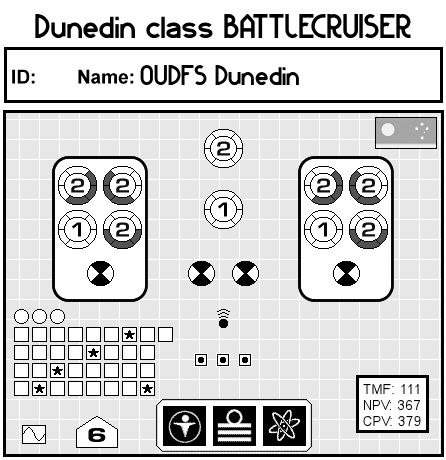 |
OUDFS Dongara
The OUDFS Dongara and others have been used as fast
"blockade runners" carrying a cargo module and a landing craft
module.
 |
OUDFS Deakin
In a unique 'Strike' configuration with 2 Torpedo modules
intended to use the
ships high thrust with the torpedo's
longer
range.

|
|
|
|
|
|
Cooma class BATTLESHIP
Sister ships: Christchurch, Canberra....
FT-910
TMF: 124
NPV: 347 + modules
CPV: 377 + modules
Technical Specifications:
Classification : Battleship
Displacement : 12400 Tonnes [MASS Factor 124]
including payload modules
Hull Type : Average [Hull Integrity 37 in 4 rows]
Crew : 17 Officers, 83 Ratings + Module Crews
Armament : 1 Class 2 Battery (All), 1 Class 1
Battery (All) (+ modules)
Defences : Grade 6 Armour, 1 Point Defence System,
Level 2 Screens (+ modules)
Sensor Suite : Standard sensors, 3 Fire Control
Systems (+ modules)
Drive Systems : Main Drive rating 4, FTL (Jump)
Drive
Modules : 3 8-Mass modules
Service Details
<<Classified>>
|
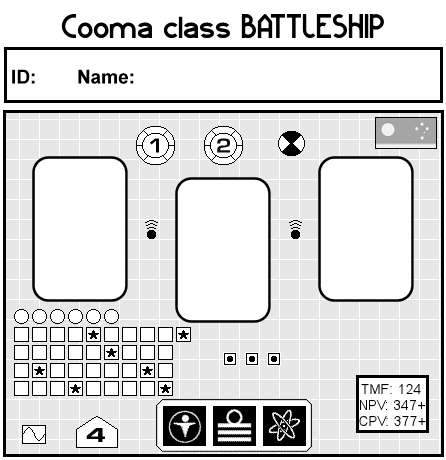
OUDFS Canberra
In a common configuration.
Coomas almost invariably operate with three Gunpack or
Standard modules, though very occasionally they carry an Defence/Escort
module instead. So far no Coomas have been seen carrying
civilian/auxiliary modules.
|

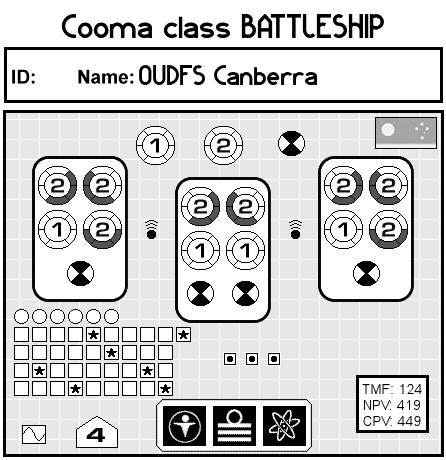 |
|
The largest ships easily constructed by the OUDF's
mid-sized military spaceyards, the Cooma class is also one of the most
heavily protected vessels of its size. Offensive combat power has been
sacrificed to make way for additional protection, but the large screens
have led to a relatively fragile hull by OU standards. Lack of funds has
led to fewer of these capable ships being produced than the OU would like.
|
|
Auckland class CARRIER
Sister ships: Aeotearoa, Armidale, Adelaide...
TMF: 128
NPV: 411 + module & fighters
CPV: 331 + module & fighters
Technical Specifications:
Classification : Carrier
Displacement : 12800 Tonnes [MASS Factor 128]
including payload modules
Hull Type : Average [Hull Integrity 37 in 4 rows]
Crew : 20 Officers, 100 Ratings + Module and
Flight Crews
Armament : 1 Class 2 Battery (All), 1 Class 1
Battery (All), 3 Fighter Bays
(+ module)
Defences : Grade 3 Armour, 2 Point Defence
Systems, Level 1 Screen (+ modules)
Sensor Suite : Standard sensors, 2 Fire Control
Systems (+ modules)
Drive Systems : Main Drive rating 4, FTL (Jump)
Drive
Modules : 1x 8-Mass module
|

Service Details
<<Classified>>
|
 |
|
The Auckland-class carriers resulted from a major refit
of the Cooma-class battleships, replacing both weapon outriggers with
hangar bays similar to those on the smaller Waikato class. The resulting
ship was too large for the OUDF's space docks to handle, causing serious
cost overruns; and their critics pointed out that the only real advantage
they had over the Waikatos were one additional fighter group - a fighter
group which the OUDF would have problems crewing anyway - and that in
spite of the "fleet carrier" classification the Auckland
nevertheless had fewer fighters than the major navies' *light* carriers.
The admiralty persisted, replying that the fleet needed more fighter cover
and that the Auckland did carry 50% more fighters than the Waikato for
only 25% extra cost; but to date production of the Aucklands has been even
slower than that of the Cooma-class battleships.
|
|
OUDFS Auckland
In a common configuration.
The Aucklands usually carry an
Defence/Escort or Standard module. Usual fighter complement is two
standard and one heavy squadrons (NPV 66, CPV 156)
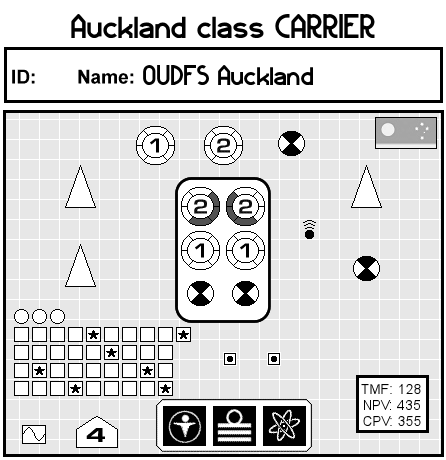
|
OUDFS Armindale
In a second common configuration with an Escort module.
Usual fighter complement in this role is three standard fighter squadrons
(NPV 54, CPV 144)
 |
OUDFS Albury-Wodonga
In an attempt to field even more fighters, there is a
proposed refit for the Auckand to allow a 4th fighter bay at the cost of
thrust, armor and a PDS system. Ftr complement of 2 Std and 2 Hvy squadrons
(NPV 96, CPV 216)
 |
|
|
|
|
|
|
|
|
|
|
Jervis Bay class MODULAR FLEET AUXILIARY |
|
|
Sister ships: Jackaroo, Jindlaee, Jerrabomberra...
TMF: 144
NPV: 280 + modules
CPV: 343 + modules
Technical Specifications:
Classification : Fleet Auxiliary
Displacement : 14400 Tonnes [MASS Factor 144]
including payload modules
Hull Type : Weak [Hull Integrity 29 in 4 rows]
Crew : 10 Officers, 40 Ratings + Module Crews
Armament : 1 Class 2 Battery (Fore), 2 Class 1
Batteries (All), (+ module)
Defences : No Armour, 2 Point Defence Systems, No Screen (+ modules)
Sensor Suite : Standard sensors, 1 Fire Control
System (+ modules)
Drive Systems : Main Drive rating 2, FTL (Jump)
Drive
Modules : 10 x 8-Mass BORON modules
Service Details
<<Classified>>
|

|
|
Like the Auckland-class carriers the Jervis Bay-class
fleet auxiliaries were too big for the Oceanic Union's own military
spaceyards to build, so instead they were built to BORON specs by the
major civilian yards at Proxima Centauris. Many intelligence analysts
initially believed them to be small dreadnoughts (and two of these ships,
Jaika Jaika and Jerilderee, did in fact temporarily serve in that role during the Siege
of Sol with all ten module wells fitted with combat modules); but their
weak main drives and defences and their lack of fire control facilities
make them very unsuited for front-line combat duties.
Although the modular design of the Jervis Bay class
allows these ships to be rapidly reconfigured to a wide variety of roles,
from planetary bombardment monitors and troop transports to long-range
survey ships or even disaster relief, their most common task is to serve
as fleet supply ships. When operating in combat zones, eg. while
supporting the OUDF Deep Space Raiding Force that raided Kra'Vak supply
lines, they usually carry at least a "Standard" weapons module
and often an "Escort" module as well to allow them to fight off
any enemy patrol craft they happen to encounter.
The speculations about OUDF dreadnoughts were not
entirely unfounded. At the time the Jervis Bay was designed the OUDF
BuShips did draw up specs for a heavy battleship with the same general
hull configuration as a Jervis Bays but with fewer module wells and more
powerful engines and defences, and rumour has it that the existing Jervis
Bay class ships are prepared to be refitted into this configuration should
the need for such heavy combat units arise – or, according to more
cynical commentators, should the OUDF's budget ever allow it!
|
|
OUDFS Jervis Bay
In a common configuration.
The most varied of the new designs are (of course) the
Jervis Bays. Their normal loadout when operating in combat zones is a
Standard module, possibly one Defence/Escort module and the remaining 8-9
wells filled with various auxiliary/civilian modules (ranging from pure
cargo modules to troop landers to sickbays to ortillery).
 |
OUDFS Jaika
Jaika and OUDFS Jerilderee
As outfitted during the Siege of Sol
During the Siege of Sol the OUDFS Jaika Jaika and OUDFS
Jerilderee carried 8 Gunpack modules each. In the two remaining
slots the Jaika Jaika carried a Defence/Escort module and one of the old
Numbat P-torp modules, while the OUDFS Jerilderee had *two* P-torp modules
- not because they expected to use the P-torps much (single-arc P-torps
don't agree very well with thrust-2 engines!), but because they needed the
extra FCS capacity. Both ships survived the Siege; after the first
couple of encounters, the Kra'Vak generally preferred to stay well away
from them!

 |
|
|
|
|
Brisbane class HEAVY BATTLESHIP |
|
|
(UNDIA analysts' best guess):
TMF: 144
NPV: 392 + modules
CPV: 455 + modules
Technical Specifications:
Classification : Heavy Battleship
Displacement : 14400 Tonnes [MASS Factor 144]
including payload modules
Hull Type : Average [Hull Integrity 43 in 4 rows]
Crew : 24 Officers, 110 Ratings + Module Crews
Armament : 3 Class 2 Batteries (Fore, FP, FS), 2 Class 1
Batteries (All), (+ module)
Defences : Grade 5 Armour, 2 Point Defence
Systems, 1 Screen (+ modules)
Sensor Suite : Standard sensors, 3 Fire Control
Systems (+ modules)
Drive Systems : Main Drive rating 4, FTL (Jump)
Drive
Modules : 4 x 8-Mass BORON modules
If the OU built a real warship based on the Jervis Bay
hull, analysts best guess is something like this.
|

OUDFS Brisbane
In a conjectural configuration.
Brisbane class heavy battleships would, if they existed,
most likely be equipped with one Defence/Escort module and three Gunpack
or Standard modules
NPV 490 / CPV 553
|
A master miniature for the Jervis Bay/Brisbane was created but there
were too many issues with the molding and casting of this ship that it was
never released.
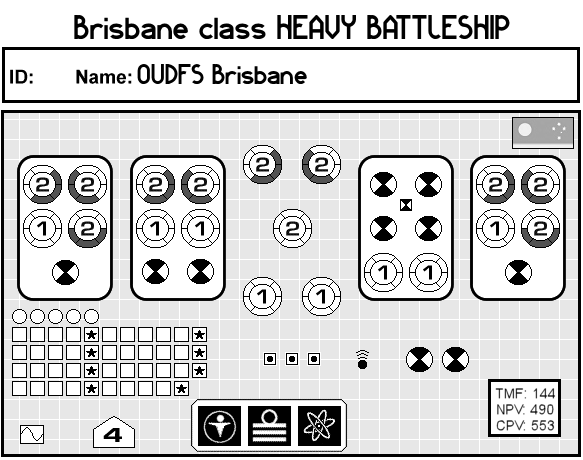 |
|